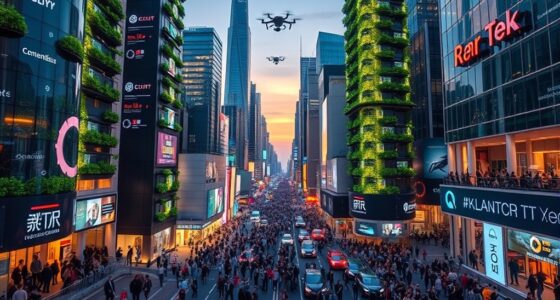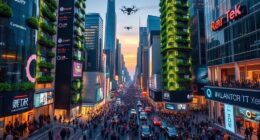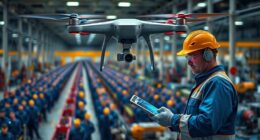As automation and AI reshape the economy, your role in work shifts towards new sectors like digital industries, healthcare, and renewable energy. Traditional jobs may decline, but new opportunities in creative and cultural fields will grow. Society is also redefining purpose beyond employment, emphasizing well-being and innovation. Safeguards like modernized safety nets are essential, and if you continue exploring, you’ll discover how these changes influence your future in a post-labor world.
Key Takeaways
- Automation and AI are transforming industries, reducing traditional jobs while creating new opportunities in healthcare, education, and cultural sectors.
- Digital industries are driving economic growth, fostering remote work, and enabling innovative cultural expressions and societal transformation.
- Societies are shifting towards inclusive safety nets, emphasizing resilience, adaptability, and redefining purpose beyond conventional employment.
- Cultural industries are expanding, prioritizing subjective well-being, diversity, and new forms of leisure, shaping societal values in a post-labor era.
- Holistic well-being practices like music therapy and societal resilience initiatives support adaptation to evolving cultural and economic paradigms.
The Evolution of Work in a Changing Economy

As the global economy evolves, the nature of work is undergoing profound change driven by technological advancements, demographic shifts, and shifting economic priorities. You’ll see new jobs emerge while others disappear; roughly 14% of current roles will be replaced, and 8% will vanish. Full-time and part-time work fluctuate as industries adapt to economic and societal changes. Digital access and innovation are transforming how businesses operate, creating opportunities in sectors like care, education, and renewable energy. Meanwhile, demographic shifts influence workforce composition and job availability. As these trends unfold, you’ll need to stay flexible and develop new skills, especially as about 39% of existing skills become outdated by 2030. The landscape is shifting, requiring a proactive approach to navigate this evolving world of work. Moreover, ongoing research from organizations like the U.S. Census Bureau and the Bureau of Labor Statistics sheds light on these changing patterns, helping policymakers and workers adapt effectively. Additionally, understanding workforce demographics is crucial for designing policies that support equitable economic growth. The increasing integration of automation and artificial intelligence further accelerates these changes, requiring workers to adapt to new tools and workflows. Recognizing the importance of personality traits in the workplace can also enhance adaptability and resilience in this shifting environment. To effectively manage these transitions, embracing a mindful approach to change can help individuals and organizations remain resilient and focused during periods of uncertainty.
Automation, AI, and the Future Job Landscape
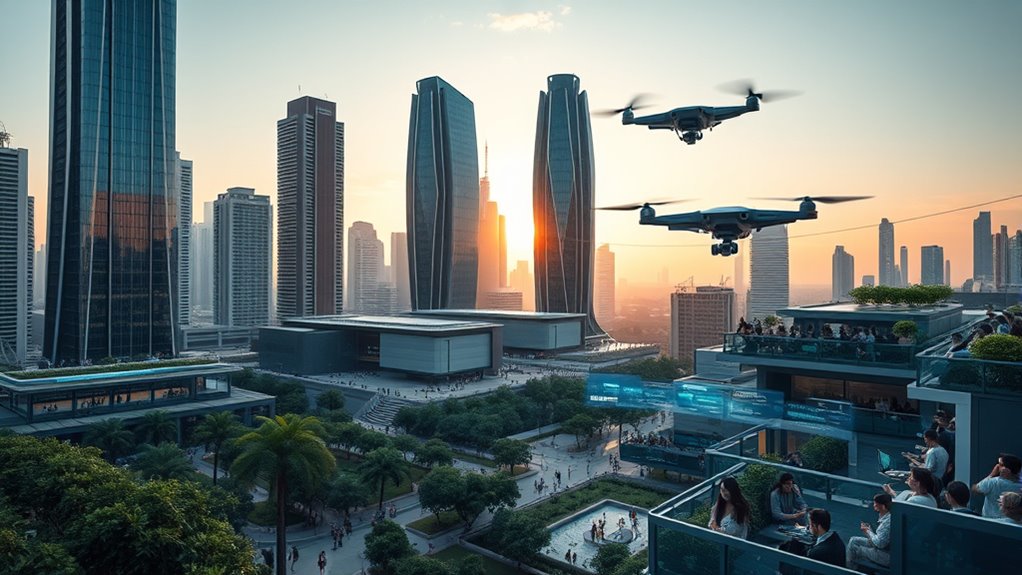
Automation and AI are reshaping the future job landscape by replacing routine tasks and creating new opportunities across industries. Nearly half of U.S. workers face job loss risk within the next decade, with 300 million jobs globally potentially affected by AI automation. Manufacturing, especially, is vulnerable due to automation of repetitive tasks, while sectors like healthcare and education are poised for growth thanks to AI enhancements. Although about 14% of workers have already been displaced, AI is expected to generate 133 million new jobs by 2025, outpacing losses by 75 million. Entry-level and white-collar roles will see significant shifts, with 40% of employers planning reductions. To thrive, you’ll need to embrace reskilling, adapt to new roles, and leverage AI as a tool for collaboration and productivity. Widespread automation could affect 1.2 billion employees (McKinsey). Additionally, the integration of Natural Language Processing (NLP) into business practices is enabling more personalized customer interactions and streamlining feedback collection, which can help organizations adapt more quickly to these labor market changes. Developing ethical considerations around AI deployment is also crucial to ensure responsible and equitable technological integration.
New Sectors and the Rise of Digital Industries
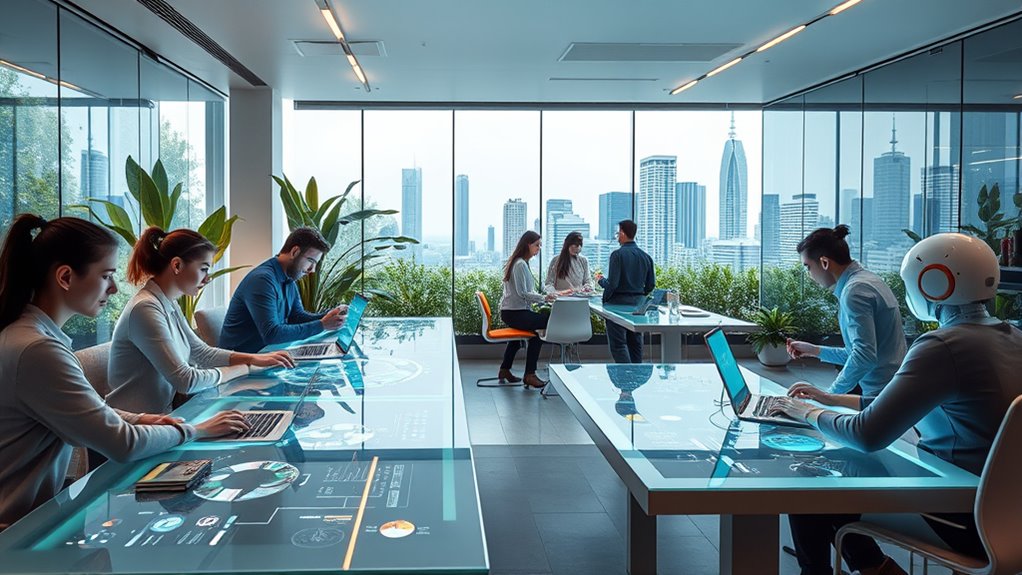
The digital landscape is transforming rapidly, creating new sectors that drive economic growth and reshape how businesses operate. You’ll see this through soaring digital markets, expected to hit over $1 trillion by 2025, and $2.5 trillion in digital transformation spending in 2024, reaching $3.9 trillion by 2027. These changes boost global GDP by $100 trillion via platform interactions and cloud solutions, essential for scalable growth. Companies that adapt quickly gain competitive advantages, leveraging digital tools for customer engagement and automation. Here’s a quick overview:
| Key Digital Sectors | Growth Drivers |
|---|---|
| Cloud Infrastructure | Cloud-based tech growth |
| Digital Marketplaces | Platform interactions |
| Data Centers | Support for digital expansion |
| Software & Applications | Innovation and efficiency |
| Digital Skills | Workforce adaptability |
Furthermore, the development of self-watering plant pots exemplifies how innovative solutions are emerging across various industries to promote sustainability and efficiency. As these sectors expand, the importance of digital skills becomes increasingly vital for workforce adaptability and future-proofing economies. Additionally, the rise of remote work is accelerating the demand for robust digital infrastructure and skills development. Advancements in AI-powered automation are also accelerating the transformation of traditional industries, enabling more efficient operations and new business opportunities. Moreover, integrating industry-specific tuning techniques from sectors like automotive can inspire innovative approaches to optimizing digital workflows and systems.
Policies and Social Safety Nets for a Post-Labor Society

The rapid growth of digital industries is reshaping the workforce landscape, prompting a reevaluation of social safety nets designed to support workers in times of need. These programs—like unemployment benefits, pensions, and health insurance—aim to guarantee a basic standard of living and aid recovery from hardships. They are divided into social insurance, social assistance, and labor market programs. However, current safety nets often fall short during crises, with complexities and financial constraints limiting their effectiveness. Recent policies, such as the American Rescue Plan and COVID-19 relief efforts, have expanded support, but gaps remain. Moving forward, you’ll need modernized, inclusive programs that leverage technology, adapt to new work arrangements, and address deep-rooted inequalities to sustain social stability in a post-labor world. Incorporating vetted solutions for Mother, Baby, and Kids can further enhance the social safety framework, especially for vulnerable populations. Furthermore, understanding diverse design options in social programs can help tailor support systems to meet varied community needs effectively, including innovative approaches like digital safety nets and flexible benefit structures. Additionally, integrating data tracking and analytics can improve the responsiveness and efficiency of these support systems, ensuring timely assistance during crises. As these systems evolve, prioritizing equity and accessibility will be crucial to ensure no groups are left behind in the transition to a post-labor society.
Cultural Shifts and Redefining Purpose in a Workless World
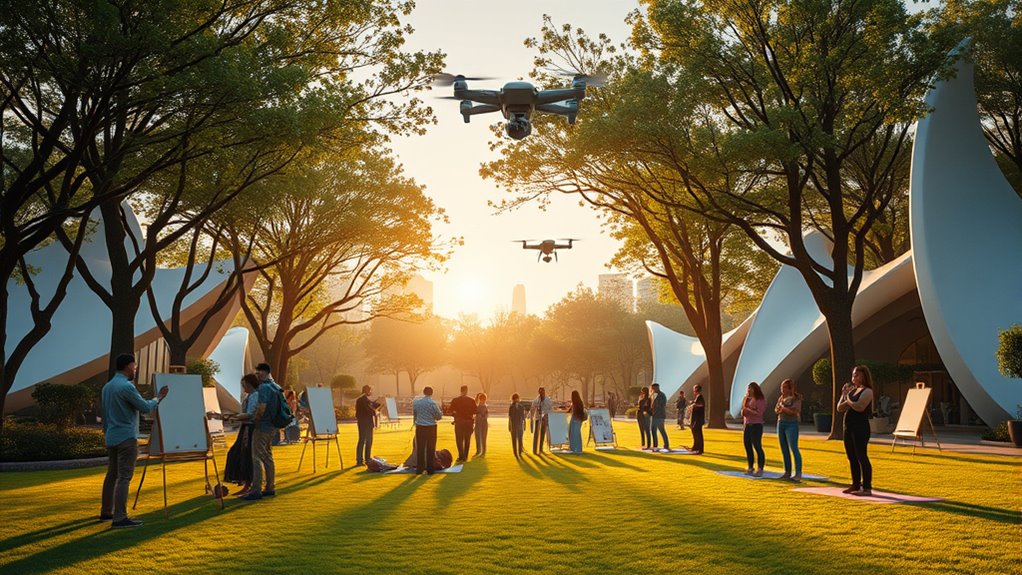
As societies shift away from traditional employment, cultural attitudes about work and purpose are undergoing profound transformation. You may notice a rise in cultural employment, which now makes up 3.8% of total EU jobs and continues to grow. Postindustrial societies embrace diversity and evolving gender norms, reshaping family structures and values. The distinction between essential and non-essential work shifts rapidly during economic or social shocks, reflecting changing beliefs. The arts sector alone employs nearly 4.9 million, highlighting cultural contributions to the economy. Societies increasingly value leisure, personal fulfillment, and subjective well-being over traditional economic measures. Digital technologies facilitate new cultural expressions and leisure activities, further transforming societal priorities. With automation and globalization, cultural industries innovate, enabling new forms of leisure and self-expression. This evolution also influences consumer preferences, including honey products, as people seek authentic and meaningful experiences. Additionally, the rise of cultural industries demonstrates how creative sectors are becoming central to economic and social development in a post-labor era. Furthermore, the integration of music therapy and sound-based practices into daily life reflects a shift toward holistic approaches that prioritize mental and emotional well-being. The emergence of remote hackathons exemplifies how innovation continues to thrive outside traditional workplaces, supporting societal adaptation to these new cultural paradigms.
Frequently Asked Questions
How Will Income Inequality Be Addressed in a Post-Labor Economy?
You might see income inequality addressed through policies like universal basic income, which provides everyone with a safety net regardless of work. Governments could also expand asset-building programs and invest in education to boost mobility. Additionally, implementing progressive taxes and ensuring inclusive technology benefits can help reduce disparities. These strategies aim to create a fairer economy where everyone has opportunities, even as traditional employment declines.
What Role Will Governments Play in Regulating AI and Automation?
You should know that governments will play a vital role in regulating AI and automation to guarantee safety, fairness, and privacy. They’ll establish rules, create standards, and monitor compliance, balancing innovation with societal needs. While federal efforts are evolving, states are also stepping in with their own laws. Internationally, governments will coordinate and adapt to diverse standards, aiming to manage risks and promote responsible AI development across borders.
How Can Societies Support Mental Health Without Traditional Work Structures?
They say, “It takes a village,” and that’s true for mental health support today. You can foster community programs, telehealth services, and social activities that give people purpose beyond work. By expanding access to mental health care, encouraging social connections, and valuing caregiving roles, society helps reduce isolation and stigma. Together, these efforts create a resilient environment where everyone’s mental well-being thrives, regardless of employment status.
Will Universal Basic Income Become a Global Standard Policy?
You wonder if universal basic income will become a global standard. Given the ongoing trials worldwide, increasing evidence shows UBI’s benefits in reducing poverty and boosting well-being. Countries are experimenting with different models, and public support is rising. While funding and scalability pose challenges, automation and economic shifts make UBI a promising solution. If these trends continue, it’s likely that more nations will adopt UBI as a standard policy worldwide.
How Might Community Engagement Evolve Without Traditional Employment?
Did you know that 70% of communities see increased social interaction through local events? Without traditional employment, your community might focus more on shared activities, volunteering, and neighborhood gatherings. You’ll likely find stronger social networks for emotional support and resource sharing. Community-led health, education, and innovation programs could flourish, giving you new ways to connect, learn, and grow. Engagement shifts from work-based to community-driven, making your local area more vibrant and supportive.
Conclusion
As you step into this bold new world, remember that the future isn’t just about machines replacing jobs—it’s about redefining purpose and community. You’re on the cusp of a revolution so profound it could reshape society faster than you can blink. Embrace the change, advocate for smart policies, and find new passions beyond work, because in this post-labor era, your potential is limitless—like an uncharted universe waiting for your exploration.



